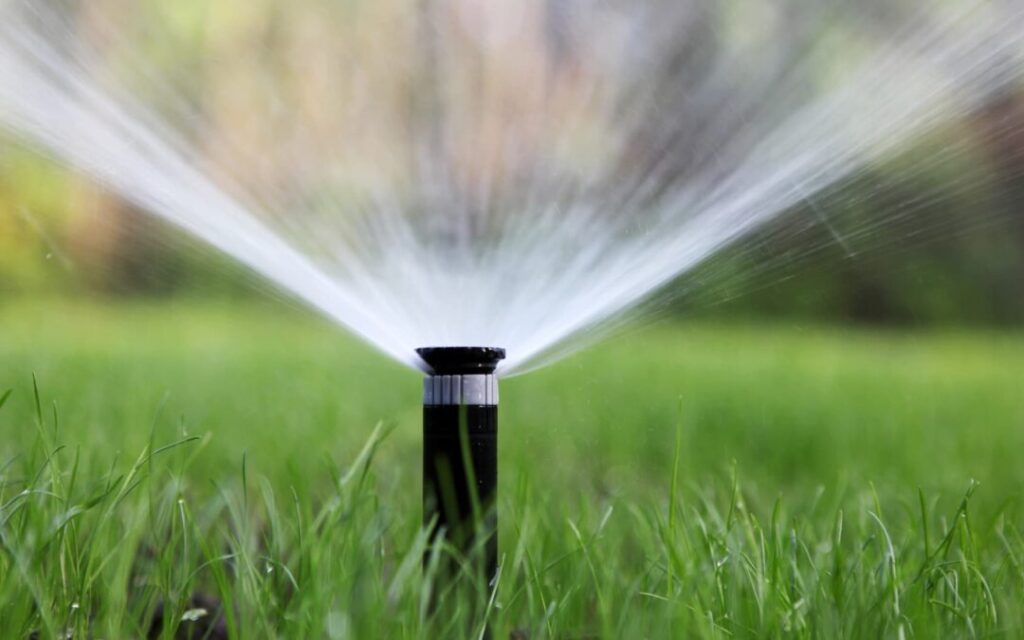A well-designed irrigation system is essential for maintaining a healthy, green lawn while conserving water and reducing utility bills. With multiple options available, homeowners in Grayson and Collin County, TX, must consider factors like yard size, soil type, climate, and water efficiency before choosing the right system. Understanding the different types of irrigation systems helps ensure that your lawn gets optimal hydration without unnecessary water waste.
1. Understanding Your Lawn’s Needs
Not all lawns require the same watering method. Factors to consider include:
- Lawn Size – Large lawns need efficient, wide-area coverage.
- Soil Type – Sandy soil drains quickly, while clay soil retains water longer.
- Climate – Hot summers in Texas require systems that prevent overwatering and runoff.
- Plant Types – Grass, flowers, trees, and shrubs may require different watering schedules.
- Water Pressure – Low water pressure affects sprinkler performance.
Evaluating these factors ensures your irrigation system is both effective and cost-efficient.
2. Types of Irrigation Systems
Each irrigation system has unique benefits and ideal use cases. Choosing the right one depends on your landscape’s layout and water efficiency goals.
Sprinkler Irrigation Systems
A sprinkler system is one of the most common choices for homeowners. It uses spray heads or rotating nozzles to distribute water evenly across the lawn.
Pros:
✔ Covers large areas efficiently
✔ Works well for grassy lawns and flower beds
✔ Can be automated with smart controllers
Cons:
✘ Can result in water waste if not properly adjusted
✘ Not ideal for small or irregularly shaped areas
Drip Irrigation Systems
Drip irrigation is a highly efficient system that delivers water directly to the plant roots through tubing and emitters.
Pros:
✔ Saves up to 50% more water than traditional sprinklers
✔ Reduces evaporation and runoff
✔ Ideal for gardens, trees, and shrubs
Cons:
✘ Requires periodic maintenance to prevent clogs
✘ Not suitable for large grassy areas
Soaker Hoses
Soaker hoses release water slowly through tiny pores, allowing moisture to seep directly into the soil.
Pros:
✔ Easy to install and maintain
✔ Ideal for flower beds and vegetable gardens
✔ Reduces water runoff and evaporation
Cons:
✘ Not suitable for large or sloped areas
✘ Can develop uneven watering if not properly positioned
Smart Irrigation Systems
Smart irrigation systems use weather data and soil sensors to adjust watering schedules automatically.
Pros:
✔ Reduces water waste by up to 30%
✔ Allows remote control via smartphone apps
✔ Adjusts watering based on rainfall, temperature, and soil moisture
Cons:
✘ Higher initial cost
✘ Requires Wi-Fi connectivity for full functionality
3. How to Choose the Right Irrigation System for Your Lawn
Now that you know the different types of irrigation systems, consider these factors before making a decision.
A. Assess Your Yard’s Layout
- Flat Lawns: Sprinkler or smart irrigation works well.
- Hilly Areas: Drip irrigation prevents runoff and erosion.
- Small Spaces: Soaker hoses or drip irrigation are ideal.
B. Water Conservation Goals
If reducing water waste is a priority, a smart irrigation or drip system is the best option. Texas homeowners can save thousands of gallons of water annually using efficient irrigation solutions.
C. Budget Considerations
- Drip irrigation is cost-effective for gardens and trees.
- Sprinkler systems are an upfront investment but increase property value.
- Smart systems have higher initial costs but result in long-term water savings.
D. Local Water Restrictions & Regulations
Many Texas cities, including Plano, Frisco, and McKinney, have water restrictions to prevent overuse and waste. Some areas even offer rebates for water-efficient irrigation systems.
4. Benefits of a Professionally Installed Irrigation System
While DIY installation may seem like a cost-saving option, professional irrigation installation ensures:
✔ Proper water pressure and zoning
✔ Efficient coverage without overspray
✔ Long-term cost savings on water bills
✔ Compliance with local water conservation laws
Hiring an expert irrigation company guarantees the best results and extends the lifespan of your system.
5. Common Irrigation Mistakes to Avoid
Even the best irrigation system can fail due to poor setup or lack of maintenance. Avoid these mistakes to ensure optimal performance:
- Overwatering – Leads to root rot and fungal growth.
- Ignoring Leaks – Small leaks can waste hundreds of gallons of water.
- Mismatched Sprinkler Heads – Results in uneven watering.
- Improper Scheduling – Watering during peak sun hours increases evaporation.
6. Maintaining Your Irrigation System for Maximum Efficiency
Regular maintenance keeps your system running efficiently. Simple seasonal adjustments can prevent costly repairs.
Monthly Maintenance Checklist
✅ Check for leaks or clogged nozzles
✅ Adjust watering schedules based on season
✅ Inspect soil moisture levels
✅ Clean or replace filters in drip systems
✅ Test sensors in smart irrigation systems
A yearly professional inspection can detect hidden issues and improve long-term efficiency.
7. Why Invest in an Automated Irrigation System?
Automated irrigation systems provide consistent watering without manual adjustments. Homeowners with busy schedules benefit from:
✔ Hands-free lawn maintenance
✔ Smart technology for precise watering
✔ Reduced water waste and lower bills
With increasing drought conditions in Texas, automated irrigation is a smart investment for homeowners and businesses.
Call Efficient Irrigation Systems for Expert Irrigation Installation
Choosing the right irrigation system improves lawn health, reduces water waste, and lowers utility bills. Efficient Irrigation Systems provides professional installation, maintenance, and repairs for homeowners in Grayson and Collin County, TX.






